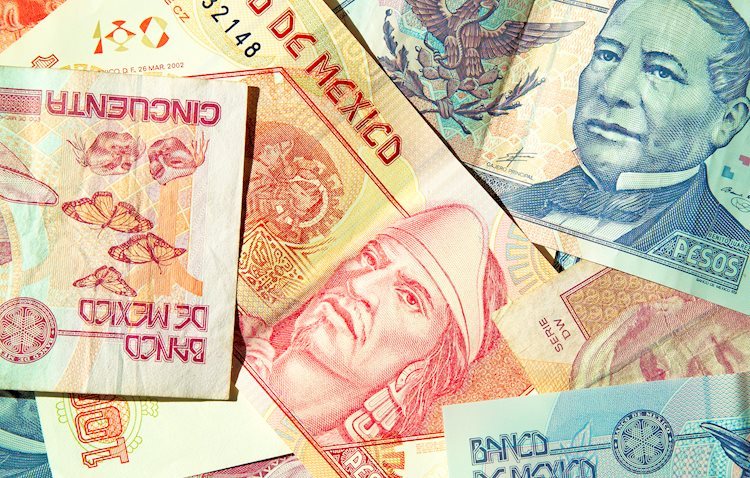- Mexican Peso remains in control at around the weekly lows, with the USD/MXN trading between 17.93/18.00.
- Mexico’s growth estimates upward revised by the International Monetary Fund to 3.2%.
- Dovish stance by Federal Reserve officials weighed on US Treasury yields, dropping from multi-year highs.
Mexican Peso (MXN) gathered traction versus the US Dollar (USD) in the mid-North American session, as risk appetite drives price action amidst falling US bond yields. US Federal Reserve (Fed) officials remained dovish a headwind for the USD/MXN pair, which is exchanging hands at around 18.00.
Mexico’s economic docket remains absent, with the emerging market currency remaining underpinned by market mood. Atlanta’s Fed President Raphael Bostic commented that monetary policy is already restrictive, while recent data from the United States (US) showed deterioration amid small business sentiment, while consumers expect inflation to remain at around 3% for a three-year period. In the meantime, the International Monetary Fund (IMF) lifted Latam and Caribbean GDP growth estimates to 2.3%, led by Mexico, with the IMF upward revising its growth forecast to 3.2%.
Daily Digest Market Movers: Mexican Peso hovers at around 18.00 market mood, US Dollar weakness
- Atlanta’s Fed President Raphael Bostic: “We don’t need to increase rates anymore.”
- New York Fed Consumer Inflation Expectation for 1-year at 3.7%, up from 3.6%, for a three-year period at 3%, revised from 2.8%.
- The US 10-year Treasury bond yield has dropped to a new six-day low of 4.632%, a headwind for the USD/MXN.
- Wall Street is trading with solid gains of between 0.70% and 1.17%, portraying improved risk appetite.
- Mexico’s auto parts industry is expected to register a $412 million hit to production by Friday, spurred by the United Auto Workers (UAW) union strike in the US.
- Mexico’s Consumer Price Index (CPI) grew by 4.45% YoY in September, below the 4.47% of estimates.
- The core CPI inflation in Mexico stood stickier at 5.76% YoY, as widely estimated, but has broken below the 6% threshold.
- A Citi Banamex poll showed economists estimate headline inflation at 4.70% and core at 5.09% for the year’s end.
- Analysts polled by Citi Banamex foresee the USD/MXN to end 2023 at 17.80, up from 17.60, and for 2024 at 18.86, up from 18.70 two weeks ago.
- Banxico’s September poll amongst economists reported that interest rates are expected to remain at 11.25% while inflation would dip to 4.66%.
- The same poll shows the USD/MXN exchange rate is set to finish at around 17.64, down from 17.75.
- The Bank of Mexico (Banxico) held rates at 11.25% in September and revised its inflation projections from 3.5% to 3.87% for 2024, above the central bank’s 3% target (plus or minus 1%).
- Banxico’s Government Board highlighted Mexico’s economic resilience and the strong labor market as the main drivers to keep inflation at the current interest rate level.
Technical Analysis: Mexican Peso could test the 200-day Simple Moving Average, sitting at around 17.78
Mexican Peso has regained its composure, with the USD/MXN pair gaining downward traction toward the 18.00 figure due to overall US Dollar weakness. Even if the USD/MXN drops below 18.00, sellers must claim key support levels on the way down to regain control and retest the September 30 low of 17.34. First, the 200-day Simple Moving Average (SMA) at 17.78, followed by the 20-day SMA at 17.54. Conversely, if USD/MXN buyers manage to keep the exchange rate above 18.00, that could pave the way to re-test October’s high of 18.48 before challenging 18.50.
Banxico FAQs
The Bank of Mexico, also known as Banxico, is the country’s central bank. Its mission is to preserve the value of Mexico’s currency, the Mexican Peso (MXN), and to set the monetary policy. To this end, its main objective is to maintain low and stable inflation within target levels – at or close to its target of 3%, the midpoint in a tolerance band of between 2% and 4%.
The main tool of the Banxico to guide monetary policy is by setting interest rates. When inflation is above target, the bank will attempt to tame it by raising rates, making it more expensive for households and businesses to borrow money and thus cooling the economy. Higher interest rates are generally positive for the Mexican Peso (MXN) as they lead to higher yields, making the country a more attractive place for investors. On the contrary, lower interest rates tend to weaken MXN. The rate differential with the USD, or how the Banxico is expected to set interest rates compared with the US Federal Reserve (Fed), is a key factor.
Banxico meets eight times a year, and its monetary policy is greatly influenced by decisions of the US Federal Reserve (Fed). Therefore, the central bank’s decision-making committee usually gathers a week after the Fed. In doing so, Banxico reacts and sometimes anticipates monetary policy measures set by the Federal Reserve. For example, after the Covid-19 pandemic, before the Fed raised rates, Banxico did it first in an attempt to diminish the chances of a substantial depreciation of the Mexican Peso (MXN) and to prevent capital outflows that could destabilize the country.



